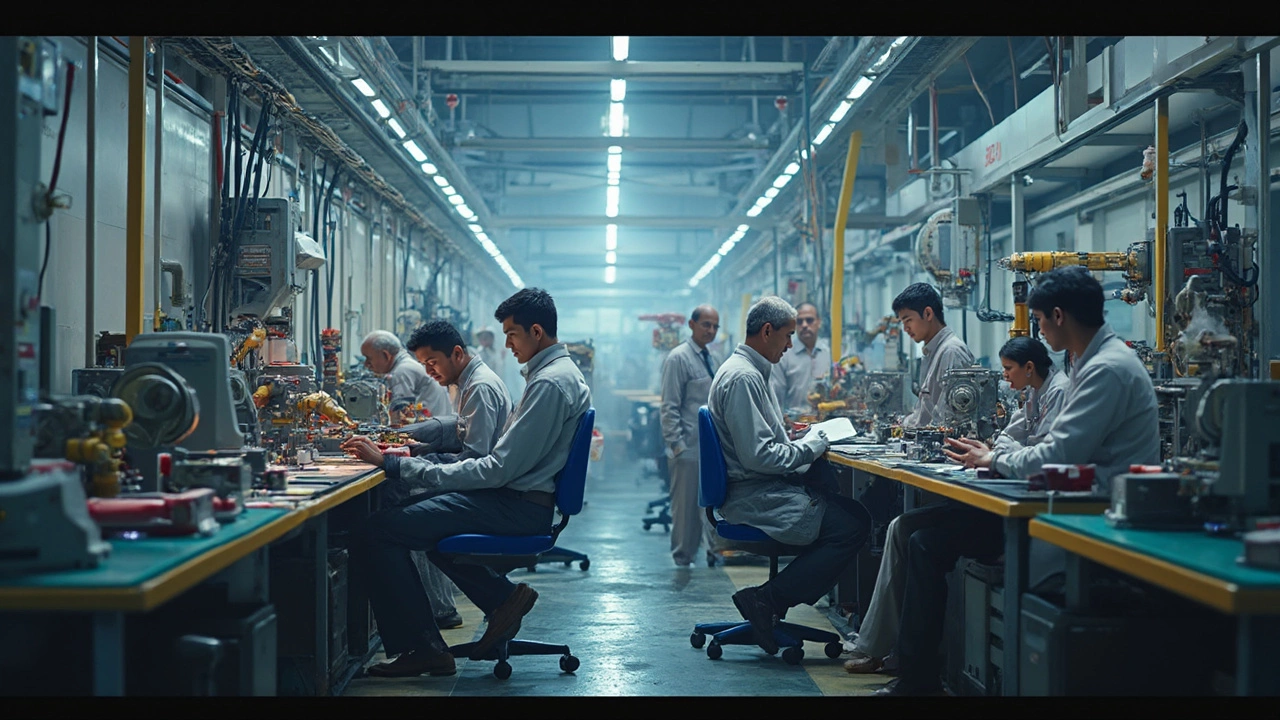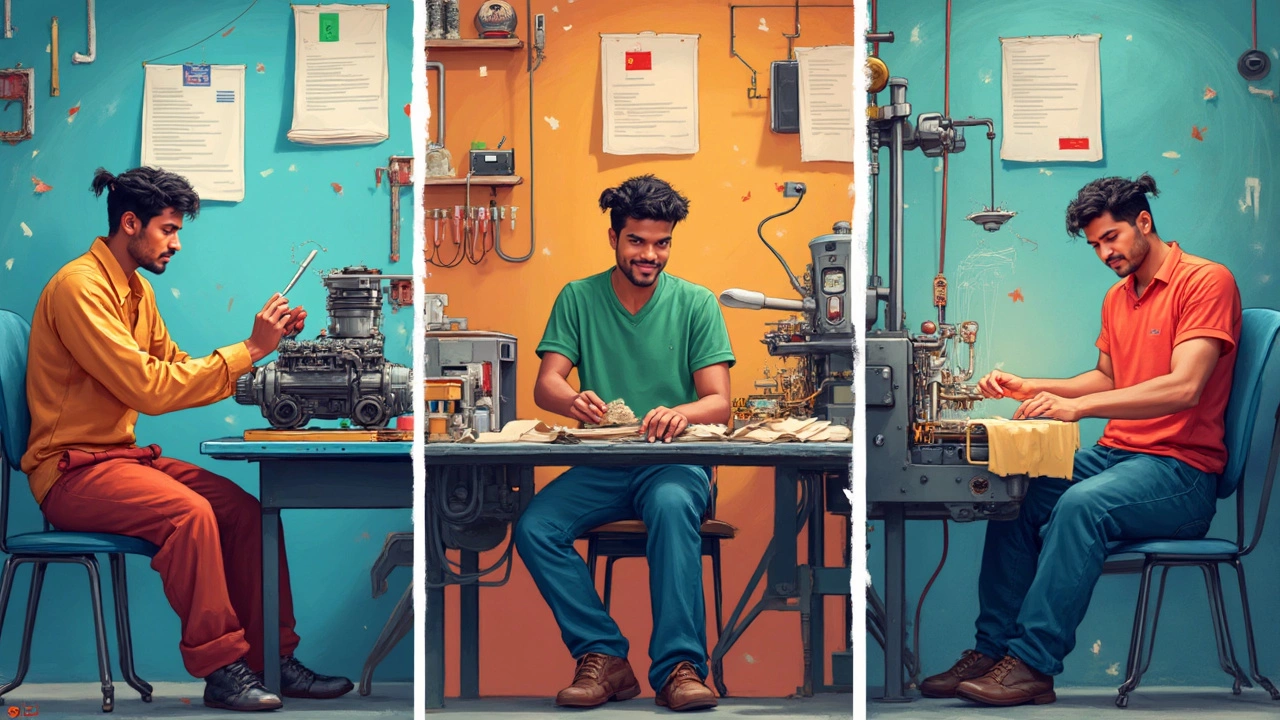
If you ask any engineer what keeps them up at night, most don't talk about simple assembly lines. They're thinking about the really tough stuff—like making microchips thinner than a hair or building rocket parts that can handle a trip to Mars. This isn't just showing off. Some manufacturing processes are so complex that even a small mistake means tossing weeks of work in the bin.
Making things at that level isn't just about fancy machines. It's about precision, laws of physics, and people who have learned to fix problems on the fly. And let's be honest, the price tag for setting up these processes can leave a company sweating bullets. That’s where government support often comes in, with grants, tax breaks, or whole training centers trying to keep local companies in the game.
Think about the tech inside your phone or the specialized parts in electric cars. None of that gets made by accident. There's a reason countries fight to have chip factories on their turf—and why government schemes around the world now focus on helping manufacturers who deal with super tricky, wafer-thin tolerances and next-level materials.
- Why Some Manufacturing Processes Are Harder Than Others
- The Crown Jewel: Semiconductor Chip Manufacturing
- How Governments Step In
- Lessons from the Trenches: Stories and Tips
- Making the Impossible Work: The Future
Why Some Manufacturing Processes Are Harder Than Others
Not all manufacturing is about stamping out the same part a million times. Some jobs take intense precision, next-level equipment, and a team who can fix things when stuff just doesn't go as planned. What really makes a process the most difficult manufacturing process? It comes down to three big factors: precision, complexity, and unpredictable problems.
If you're making plastic spoons, things go on autopilot. But if you're building parts for jet engines or chips for smartphones, the tolerances can be mind-blowing. We're talking about measurements so fine that dust particles can ruin everything. These industries need expensive clean rooms, high-tech sensors, and even crews dedicated just to quality control.
Have a look at just how much tougher these advanced processes get:
| Process | Required Tolerance | Failure Rate | Setup Cost |
|---|---|---|---|
| Plastic part injection | ±0.1 mm | Low (<1%) | $10,000 |
| Semiconductor fabrication | ±0.0005 mm | High (10-30%) | $1,000,000,000+ |
| Jet turbine blade | ±0.01 mm | Moderate (2-5%) | $10,000,000 |
Another pain point? Supply chain headaches. When you're relying on rare metals or super-specialized gear, a single missing part can hold up a whole line for weeks. Work often happens under strict regulations, especially for things like medical devices or anything that goes into airplanes or nuclear plants.
Here are some signs you’re dealing with a process that’s truly brutal on the shop floor:
- Requires a spotless environment (think: lab coats, shoe covers, and filtered air)
- Needs tools that cost more than your average house
- Involves dozens of strict tests, with products tossed if they fall short even by a hair
- Has long, complex steps—just one mistake means starting over
So, while most factories aren’t breaking a sweat making simple stuff, those tackling advanced manufacturing know they’re always a hair away from losing a lot—of money, time, and sometimes their competitive edge.
The Crown Jewel: Semiconductor Chip Manufacturing
If there’s one process that never quits when it comes to stress and complexity, it’s semiconductor chip manufacturing. People call it the most difficult manufacturing process for good reason. Each tiny chip has billions of transistors, all packed tighter than a cat hiding from bath time (trust me, I’m speaking from experience there with Socks).
You probably use chips dozens of times before breakfast—from your phone alarm to the coffee machine. But making them is a nightmare. Just the raw silicon goes through hundreds of steps in what they call a “clean room.” No, not like a tidy bedroom. We’re talking air filters a thousand times better than hospital rooms, everyone in bunny suits, and even then, the tiniest speck of dust can ruin a whole batch. A quick rundown of the process looks like this:
- Growing flawless silicon crystals from molten material
- Slicing those crystals into ultra-thin wafers
- Layer upon layer of microscopic circuit patterns are “printed” using extreme ultraviolet (EUV) light
- Each layer must line up exactly with the last, or it’s game over
- Chemical baths, high heat, and delicate etching gradually build up complex circuits
- Chips get tested, diced, and packaged for use in devices
Here’s what makes this process especially wild: the tiniest lines on cutting-edge chips now measure just 3 nanometers wide. To put that in perspective, a strand of human hair is about 60,000 nanometers. That means chip factories, or "fabs," stay on the hunt for new ways to hit even smaller numbers while avoiding defects. These factories can cost more than $15 billion and take years to construct and set up.
| Year | Smallest Chip Size (nm) | Average Cost to Build a Fab (USD) |
|---|---|---|
| 2015 | 14 | $5B |
| 2020 | 7 | $10B |
| 2024 | 3 | $15B+ |
A single mistake in one step? That’s several million dollars down the drain. It’s no surprise why countries like the US, Japan, and Germany offer giant incentives to chipmakers. They all want a piece of this ultra-high-tech pie, and no one can afford to fall behind.
For businesses, it means crazy-high start-up costs, the need for ultra-strict quality control, and having a team that can handle surprises FAST. If you want to build a plant or work in this world, patience and attention to microscopic detail aren’t just nice—they’re survival skills.

How Governments Step In
Tough manufacturing jobs aren’t just tough on companies—they’re tough for whole countries. When factories can't keep up with the world, big problems show up in jobs, national security, and even basic supply chains. That’s exactly why governments don’t just sit back and watch.
Take semiconductors, for example. The U.S. government launched the CHIPS and Science Act in 2022, sinking more than $50 billion into building and upgrading American chip factories. The aim? Get a slice of the world’s most difficult manufacturing process back onto home turf, so the country isn’t left panicking during global shortages (yep, like when new cars just sat in parking lots waiting on a single tiny part).
In India, the government rolled out Production Linked Incentive (PLI) schemes for everything from electronics to pharmaceuticals. Companies that make goods locally get cash-back for hitting production and export goals. This makes it less risky to set up expensive, sophisticated manufacturing lines here instead of somewhere else.
And let’s not forget Germany. With its “Industrie 4.0” push, the government partners with both big industry and small shops. They fund training centers, research labs, and digital upgrades, pushing German factories to stay at the top, especially in automotive and precision machinery.
- Special tax credits – offsetting costs for research or new machinery.
- Direct cash grants or low-interest loans for tech upgrades.
- Setting up training programs so workers can actually use the latest gear instead of fearing it.
- Public-private research centers—getting universities, startups, and big firms to team up on gnarly problems.
No country wants to lose ground on the hard stuff—if your factories can’t manage the tough processes, the world leaves you behind. So you get policies, campaigns, and boatloads of tax breaks, all trying to lighten the load and keep expert manufacturers competitive on the world stage.
Lessons from the Trenches: Stories and Tips
When it comes to the most difficult manufacturing process, nothing beats learning from the folks who’ve actually done it—the engineers with smudged glasses, quality managers biting their nails, and line workers with years under their belts. Semiconductor fabs (“fabs” for short) tell wild stories about a single speck of dust ruining thousands of chips, tanking millions of dollars overnight. That's why the clean rooms they work in are way more sterile than any hospital.
Let’s get concrete. In 2023, stats from the International Roadmap for Devices and Systems showed that just bumping up chip yields by 1% could mean an extra $200 million in annual revenue for a typical fab. That’s an insane margin, making precision and bulletproof processes non-negotiable.
Government programs don’t just show up with cash; they often fund training bootcamps. For example, the U.S. CHIPS Act sparked partnerships between colleges and factories, giving workers hands-on chipmaking skills from day one on the job. In Germany, state-backed labs paired with automotive suppliers, helping them master laser welding for battery packs—one tiny change made EV battery lines twice as fast, cutting energy bills by nearly 30% according to a 2024 BMW study.
Here's what pros who survived the toughest jobs recommend:
- Document every step—don’t just trust memory or word of mouth. Clear SOPs (Standard Operating Procedures) catch mistakes early.
- Cross-train teams. If one person’s out sick, don’t let everything grind to a halt.
- Share failure stories openly. Big firms like Intel have “war rooms” where teams dump every problem on the table until they spot invisible trends.
- Monitor sensor data nonstop—real-time dashboards helped a South Korean display plant spot a failing filter before it blew out a $5 million run, per a 2024 field report.
- Keep suppliers close. A Japanese automaker cut chip shortages by pulling suppliers into weekly troubleshooting calls (not just meeting once a month), keeping the ball rolling even when things got weird.
Check out this bite-sized look at how government efforts and smart tactics have paid off in the last couple years:
| Year | Project | Impact |
|---|---|---|
| 2023 | CHIPS Act (U.S.) – College partnerships | 3,200 new skilled workers in semiconductors by year-end |
| 2024 | German EV battery welding boost | Production speed doubled; energy costs cut by 30% |
| 2024 | South Korean display factory sensor upgrade | Saved $5M in downtime by preventing a major filter failure |
If you’re in the trenches (or want to be), don't wing it alone. Use what’s worked—from government-backed training to open communication—to get through the sticky spots. That’s how heavyweights stay ahead in manufacturing's toughest arenas.

Making the Impossible Work: The Future
Manufacturing that seemed out of reach a decade ago is quickly turning into daily reality. Take the recent breakthroughs in chip foundries—these places are now etching out circuits at just three nanometers. For reference, a human hair is about 80,000 nanometers wide. Only companies like TSMC and Samsung have pulled this off, and they’re not stopping there. Roadmaps now talk about two or even one-and-a-half nanometer chips in the next few years.
But there’s no magic here. Getting there takes government-backed R&D, loads of trial and error, and people who constantly learn new tricks. The push for quantum computing, battery tech that lasts longer than your phone contract, or medical devices about the size of a blood cell—those all depend on mastering the most difficult manufacturing process for each task.
Governments have started throwing more weight behind these efforts. For example, the US CHIPS Act poured over $50 billion into American microchip manufacturing. India, South Korea, and the EU have rolled out their own billions for tech factories, retraining programs, and subsidized loans. This isn’t about handouts; it’s about staying in the race while the bar keeps moving up.
So, what’s coming next? Here’s what experts and industry leaders keep bringing up:
- Digital twins and AI—Factories are doubling production by building virtual models first, finding flaws before any real material is lost.
- Automation—Robots do the boring stuff, but also now handle tasks humans can’t touch, like assembling nanomaterials or handling dangerous chemicals.
- Eco-friendly materials—There’s heavy demand for greener processes. Making batteries without toxic byproducts or recycling rare metals on-site is now a must, not a bonus.
- Upgraded training—You can’t just hire anyone off the street for this stuff. Fast-track training schemes and partnerships between universities, tech schools, and factories are growing fast.
If you’re thinking about getting into advanced manufacturing, there’s never been a better time. Look out for government incentives, keep learning (because tech moves fast), and follow companies who are already pulling off what looked impossible just a few years ago. That’s where the future’s getting built.




